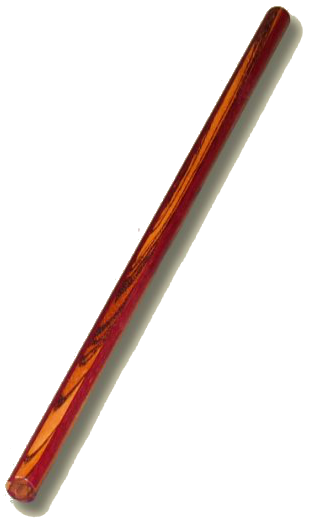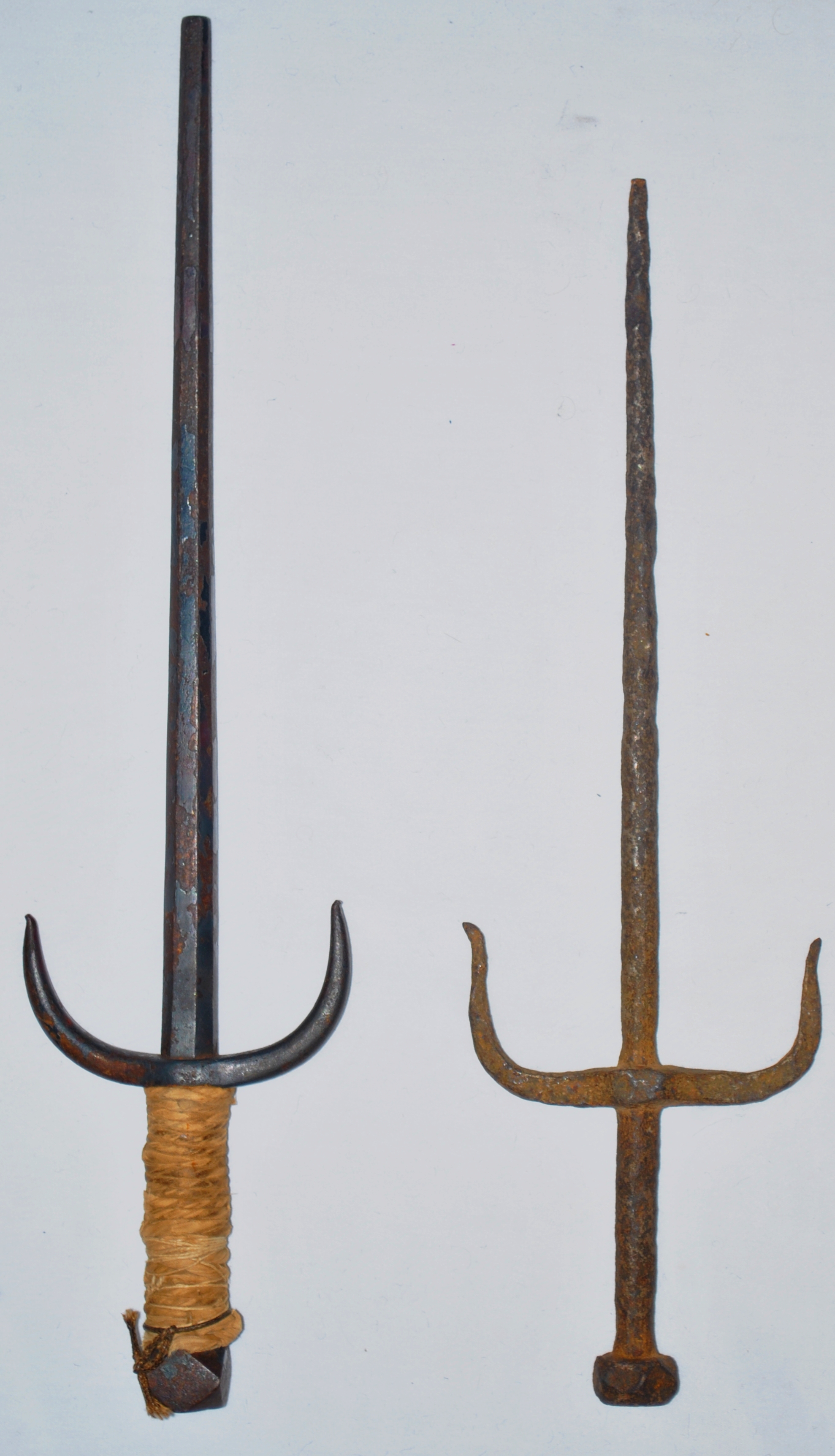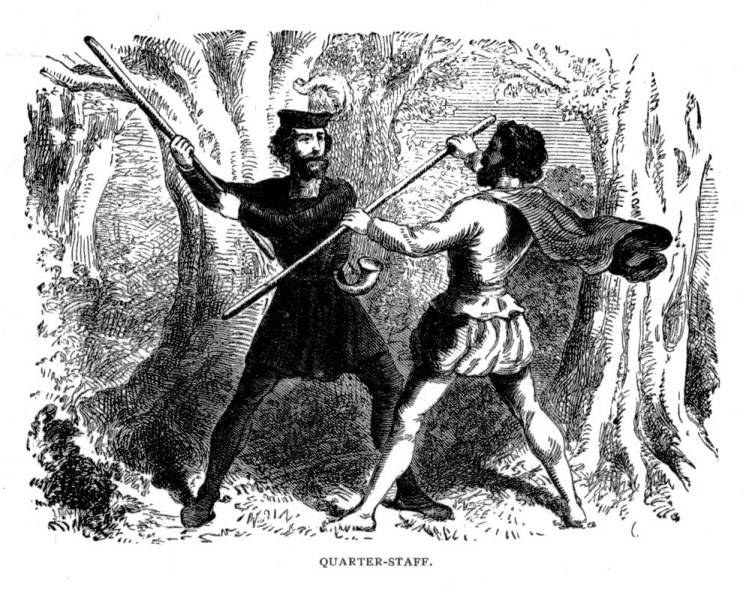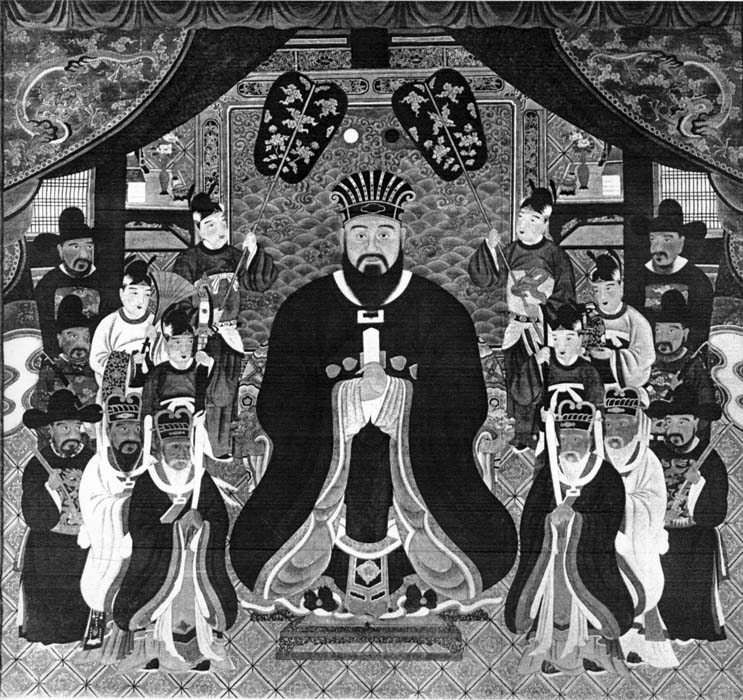|
Bō
A (''pong'' (Korean); ''pang'' (Cantonese); ''bang'' (Mandarin); ''kun'' (Okinawan)) is a staff weapon used in Okinawa. ''Bō'' are typically around long and used in Okinawan martial arts and Japanese arts such as bōjutsu. Other staff-related weapons are the '' jō'', which does not have a standard length , and the ''hanbō'' (half ''bō''), which is long. Types The ''bō'' is usually made with unfinished (no varnish, stain, etc) hardwood or a flexible wood, such as red or white oak, although bamboo and pine wood have been used; more common still is rattan wood for its strength and flexibility. The modern ''bō'' may be tapered in that it can be thicker in the center (''chukon-bu'') than at the ends (''kontei'') and is usually round or circular (''maru-bo''). Some bō are very light, with metallic sides, stripes and a grip which are used for XMA and competitions/demonstrations. Older bō were round (''maru-bo''), square (''kaku-bo''), hexagonal (''rokkaku-bo'') or octagonal ... [...More Info...] [...Related Items...] OR: [Wikipedia] [Google] [Baidu] |
Hanbō
The ''hanbō'' (半棒, "half-staff") is a Stick fighting, staff used in martial arts. Traditionally, the ''hanbō'' was approximately three ''Shaku (unit), shaku'' or about long, half the length of the usual staff, the ''rokushakubō'' ("six ''shaku'' staff"). Diameter was . However, depending on the school the length and diameter varied. As with any weapon, bearers would often find one best suited to their build, opting often for one that comes up to about waist/hip height. Usage Hanbōjutsu, the art of wielding the ''hanbō'', is a focus in several martial arts including the ''Kukishin-ryū'' ''koryū'' classical school of martial arts, and ''Kukishinden-ryū'', one of the nine schools of ''Bujinkan Budo Taijutsu''. Part of the importance in using this length is that it is approximately that of a walking cane. Although techniques with a cane in this ''ryū-ha'' utilize pulling or hooking and possess one rounded end, they invariably function the same as a ''hanbō'' in all o ... [...More Info...] [...Related Items...] OR: [Wikipedia] [Google] [Baidu] |
Bōjutsu
() is the martial art of stick fighting using a bō, which is the Japanese word for staff. Staffs have been in use for thousands of years in Asian martial arts like Silambam. Some techniques involve slashing, swinging, and stabbing with the staff. Others involve using the staff as a vaulting pole or as a prop for hand-to-hand strikes. Today ''bōjutsu'' is usually associated either with Okinawan '' kobudō'' or with Japanese '' koryū budō''. Japanese ''bōjutsu'' is one of the core elements of classical martial training. Thrusting, swinging, and striking techniques often resemble empty-hand movements, following the philosophy that the ''bō'' is merely an "extension of one’s limbs".Weapons Consequently, bōjutsu is often incorporated into other styles of empty-hand fighting, like traditional [...More Info...] [...Related Items...] OR: [Wikipedia] [Google] [Baidu] |
Okinawan Kobudō
, literally "old martial way of Okinawa", is the weapon systems of Okinawan martial arts. Etymology and definition Okinawan Kobudō is a Japanese term that can be translated as "''old martial way of Okinawa''". It is a generic term coined in the twentieth century.Donn F. Draeger, 1973. ''Classical Budo''. ., p. 135. Okinawan kobudō refers to the weapon systems of Okinawan martial arts. These systems can have from one to as many as a dozen weapons in their curriculum, among them Bō, kon (six foot staff), Sai (weapon), sai (short-handled trident), tonfa (handled club), Kama (weapon), kama (sickle), and nunchaku (two rope- or chain-connected sticks), but also the tekko (knuckledusters), tinbe-rochin (shield and spear), and surujin (weighted chain). Less common Okinawan weapons include the tambo (weapon), tambo (short stick), the hanbō (middle length staff) and the eku (boat oar of traditional Okinawan design). Okinawan kobudō is distinguished from the general term kobudō, whi ... [...More Info...] [...Related Items...] OR: [Wikipedia] [Google] [Baidu] |
Japanese Martial Art
Japanese martial arts refers to the variety of martial arts native to the country of Japan. At least three Japanese terms (''budō'', ''bujutsu'', and ''bugei'') are used interchangeably with the English phrase Japanese martial arts. The usage of the term ''budō'' (武道) to mean martial arts is a modern one: historically the term meant a way of life encompassing physical, spiritual and moral dimensions with a focus on self-improvement, fulfillment or personal growth. The terms ''bujutsu'' (武術) and ''bugei'' (武芸) have different meanings from ''budō'', at least historically speaking. ''Bujutsu'' refers specifically to the practical application of martial tactics and techniques in actual combat. ''Bugei'' refers to the adaptation or refinement of those tactics and techniques to facilitate systematic instruction and dissemination within a formal learning environment. History Each child who grew up in a samurai family was expected to be a warrior when he gre ... [...More Info...] [...Related Items...] OR: [Wikipedia] [Google] [Baidu] |
Tenshin Shōden Katori Shintō-ryū
Written as 天眞正傳香取神道流 before adoption (1946) of Tōyō kanji. is one of the oldest extant Japanese martial arts and an exemplar of ''bujutsu''. It was founded by Iizasa Ienao, who lived near Katori Shrine (Sawara, Chiba, Sawara City, Chiba Prefecture) at the time. The ''ryu (school), ryū'' is purported to have been founded in 1447, but some scholars state that it was about 1480.The year 1387 is given as Iizasa's birth year in ''Deity and the Sword'', Vol 1 pp. 16–17. Watatani (1967) speculates that 1417–1420 is correct. History Foundation Iizasa Chōisai Ienao, Iizasa Ienao (飯篠 長威斎 家直 ''Iizasa Chōi-sai Ienao'', 1387 – c. 1488) was a respected sōjutsu, spearman and swordsman whose ''daimyō'' was deposed, which encouraged him to relinquish control of his household to conduct purification rituals and study martial arts in isolation.Amdur, Ellis (2002). ''Old School: Essays on Japanese Martial Traditions'', Edgework, p. 21� ... [...More Info...] [...Related Items...] OR: [Wikipedia] [Google] [Baidu] |
Stick-fighting
Stick-fighting, stickfighting, or stick fighting, is a variety of martial arts which use blunt, hand-held "sticks" for fighting, most typically a simple, non-lethal, wooden staff or baton. Schools of stick-fighting exist for a variety of weapons, including gun staffs, bō, jō, bastons, and arnis sticks, among others. Cane-fighting is the use of walking sticks as improvised weapons. Some techniques can also be used with a sturdy umbrella or even with a sword or dagger still in its scabbard. Thicker and/or heavier blunt weapons such as clubs or the mace are outside the scope of stick-fighting (since they cannot be wielded with the necessary precision, relying on the sheer force of impact for stopping power instead), as are more distinctly-shaped weapons such as the '' taiaha'' used by the Māori people of New Zealand, and the '' macuahuitl'' used by the Aztec people of Mesoamerica in warfare. Although many systems are defensive combat techniques intended for use if atta ... [...More Info...] [...Related Items...] OR: [Wikipedia] [Google] [Baidu] |
Invasion Of Ryukyu
The by forces of the Japanese feudal domain of Satsuma took place from March to May of 1609, and marked the beginning of the Ryukyu Kingdom's status as a vassal state under the Satsuma domain. The invasion force was met with stiff resistance from the Ryukyuan military on all but one island during the campaign. Ryukyu would remain a vassal state under Satsuma, alongside its already long-established tributary relationship with China, until it was formally annexed by Japan in 1879 as the Okinawa Prefecture. Etymology The war was called the , with 1609 being a ''kiyū'' year in the sexagenary cycle. It was also called the by the Ryukyu Kingdom. In Japan, the war was called the or the during the Edo period, and was called the by many Japanese scholars before WWII. Background Satsuma's invasion of Ryukyu was the climax of a long tradition of relations between the kingdom and the Shimazu clan of Satsuma. The two regions had been engaged in trade for at least several centur ... [...More Info...] [...Related Items...] OR: [Wikipedia] [Google] [Baidu] |
Satsuma Domain
The , briefly known as the , was a Han system, domain (''han'') of the Tokugawa shogunate of Japan during the Edo period from 1600 to 1871. The Satsuma Domain was based at Kagoshima Castle in Satsuma Province, the core of the modern city of Kagoshima, located in the south of the island of Kyushu. The Satsuma Domain was ruled for its existence by the ''Tozama daimyō, Tozama'' ''daimyō'' of the Shimazu clan, who had ruled the Kagoshima area since the 1200s, and covered territory in the Provinces of Japan, provinces of Satsuma, Ōsumi Province, Ōsumi and Hyūga Province, Hyūga. The Satsuma Domain was assessed under the ''Kokudaka'' system and its value peaked at 770,000 ''koku'', the second-highest domain in Japan after the Kaga Domain.Conrad Totman, Totman, Conrad. (1993) ''Early Modern Japan'', p. 119 The Satsuma Domain was one of the most powerful and prominent of Japan's domains during the Edo period, conquering the Ryukyu Kingdom as a vassal state after the invasion of ... [...More Info...] [...Related Items...] OR: [Wikipedia] [Google] [Baidu] |
Karate
(; ; Okinawan language, Okinawan pronunciation: ), also , is a martial arts, martial art developed in the Ryukyu Kingdom. It developed from the Okinawan martial arts, indigenous Ryukyuan martial arts (called , "hand"; ''tī'' in Okinawan) under the influence of Chinese martial arts. While modern karate is primarily a striking art that uses punches and kicks, traditional karate training also employs Throw (grappling), throwing and joint locking techniques. A karate practitioner is called a . Beginning in the 1300s, early Chinese martial arts, Chinese martial artists brought their techniques to Okinawa. Despite the Ryukyu Kingdom being turned into a puppet state by Japanese samurai in 1609, after the Invasion of Ryukyu, its cultural ties to China remained strong. Since Ryukyuans were banned from carrying swords under samurai rule, groups of young aristocrats created unarmed combat methods as a form of resistance, combining Chinese and local styles of martial arts. Training emph ... [...More Info...] [...Related Items...] OR: [Wikipedia] [Google] [Baidu] |
Shō Shin
was a king of the Ryukyu Kingdom, the third ruler of the second Shō dynasty. Shō Shin's long reign has been described as "the Great Days of Chūzan", a period of great peace and relative prosperity. He was the son of Shō En, the founder of the dynasty, by Yosoidon, Shō En's second wife, often referred to as the queen mother. He succeeded his uncle, Shō Sen'i, who was forced to abdicate in his favor. Reign Much of the foundational organization of the kingdom's administration and economy is traced back to developments which occurred during Shō Shin's reign. As government became more institutionalized and organized, the '' aji'' (按司, local lords) gradually lost power and independence, becoming more closely tied to the central government at Shuri. In order to strengthen central control over the kingdom, and to prevent insurrection on the part of the ''aji'', Shō Shin gathered weapons from all the ''aji'' to be put to use for the defense of the kingdom, and ordered '' ... [...More Info...] [...Related Items...] OR: [Wikipedia] [Google] [Baidu] |
First Shō Dynasty
The was a dynasty of the Ryukyu Kingdom on Okinawa Island in the 15th century, ruled by the under the title of Genealogy of the Kings of Chūzan, King of Chūzan. According to the official history books compiled during the second Shō Dynasty, it lasted from 1406 to 1469. However, the official account is considered unreliable by modern historians because it contradicts contemporary sources. Official narrative During the second Shō Dynasty, Ryūkyū compiled official history books, starting with Haneji Chōshū's ''Chūzan Seikan'' (1650), which was followed by Sai Taku's edition of the ''Chūzan Seifu'' (1701) and Sai On's edition of the ''Chūzan Seifu'' (1725). Although the official narrative based on Sai On's ''Chūzan Seifu'' is widely circulated, it is full of contradictions with contemporary sources. In 1406, Bunei (Ryukyu), Bunei was overthrown and Shishō, Shō Shishō became the nominal ruler of Chūzan, placed there by his eldest son Shō Hashi as part of a power b ... [...More Info...] [...Related Items...] OR: [Wikipedia] [Google] [Baidu] |
Nanzan
Nanzan (), also known as Sannan (山南) before the 18th century, located in the south of Okinawa Island, was one of three independent political entities which controlled Okinawa in the 14th century. The political entity was identified as a tiny country, a kingdom, or a principality by modern historians, however the ruler of Nanzan was in fact not "kings" at all, but petty lords with their own retainers owing their direct service, and their own estates. Okinawa, previously controlled by a number of local chieftains or lords, loosely bound by a paramount chieftain or king of the entire island, split into these three more solidly defined kingdoms within a few years after 1314; the Sanzan period thus began, and would end roughly one hundred years later, when Chūzan's King Shō HashiTechnically, Hashi's father Shō Shishō was king of Chūzan in 1419, and neither was called "Shō" until that name was granted them by the Ming court in 1421. conquered Hokuzan in 1419 and Nanzan i ... [...More Info...] [...Related Items...] OR: [Wikipedia] [Google] [Baidu] |






